Tourism Distribution Systems: Historical Development and Future Trends
VerifiedAdded on 2023/06/12
|10
|1790
|238
Portfolio
AI Summary
This portfolio provides an in-depth analysis of tourism distribution systems, encompassing historical evolution, the role of technology, and future trends. It includes explanatory diagrams, tables, and charts illustrating key elements of the systems. The portfolio references insights from guest speakers and explores the impact of technology, such as CRS, GDS, and social media, on tourism distribution. It also examines adversarial and alliance styles of distribution systems and presents a 'future' explanatory model. Short written explanations accompany the diagrams and models, with proper referencing of adapted models. The analysis covers the evolution of electronic distribution in the travel industry, from early reservation systems to the impact of the internet and online travel agencies. The role of technology in enhancing customer experiences and streamlining operations is also discussed, along with the potential of AI in shaping future distribution systems. This portfolio offers a comprehensive overview of tourism distribution systems and their ongoing transformation.
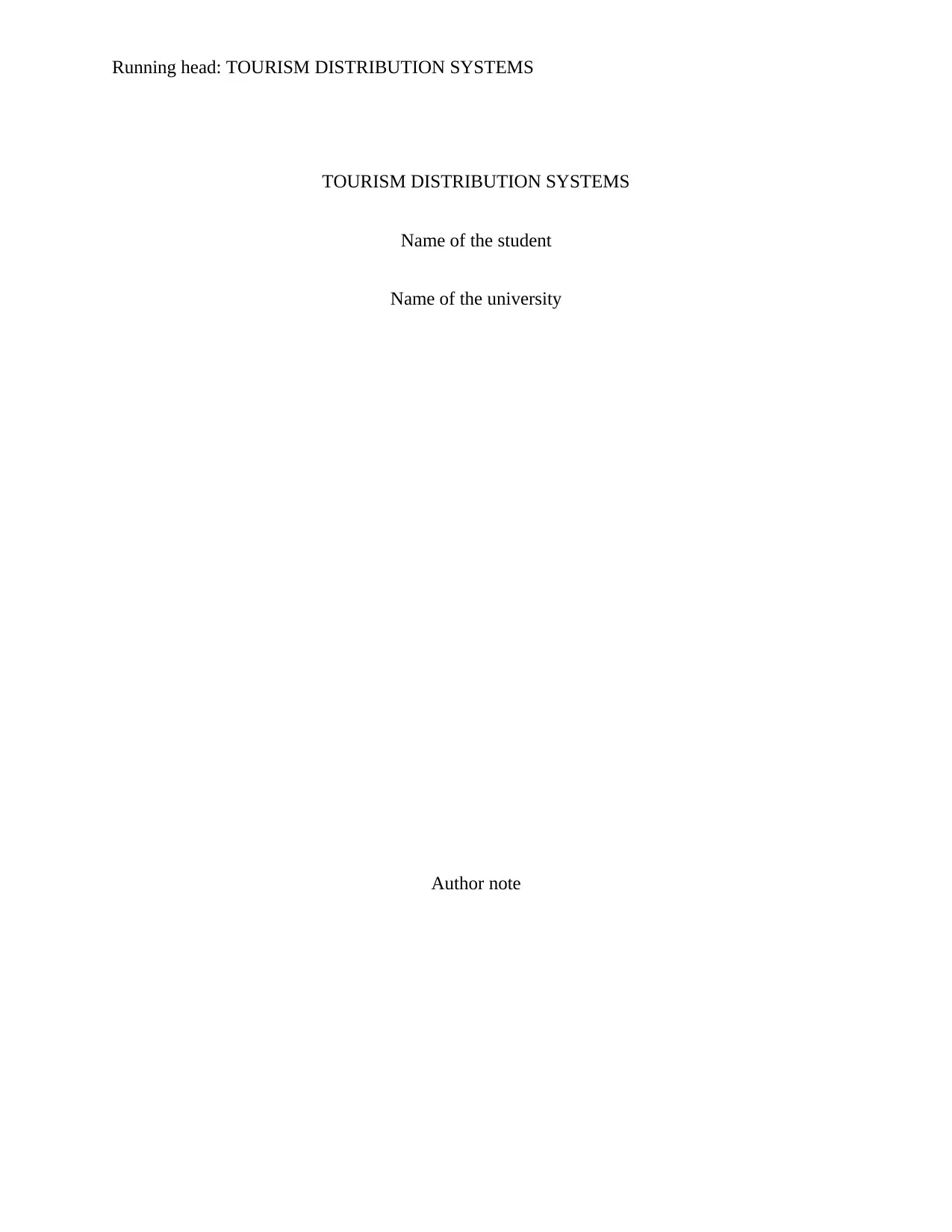
Running head: TOURISM DISTRIBUTION SYSTEMS
TOURISM DISTRIBUTION SYSTEMS
Name of the student
Name of the university
Author note
TOURISM DISTRIBUTION SYSTEMS
Name of the student
Name of the university
Author note
Paraphrase This Document
Need a fresh take? Get an instant paraphrase of this document with our AI Paraphraser
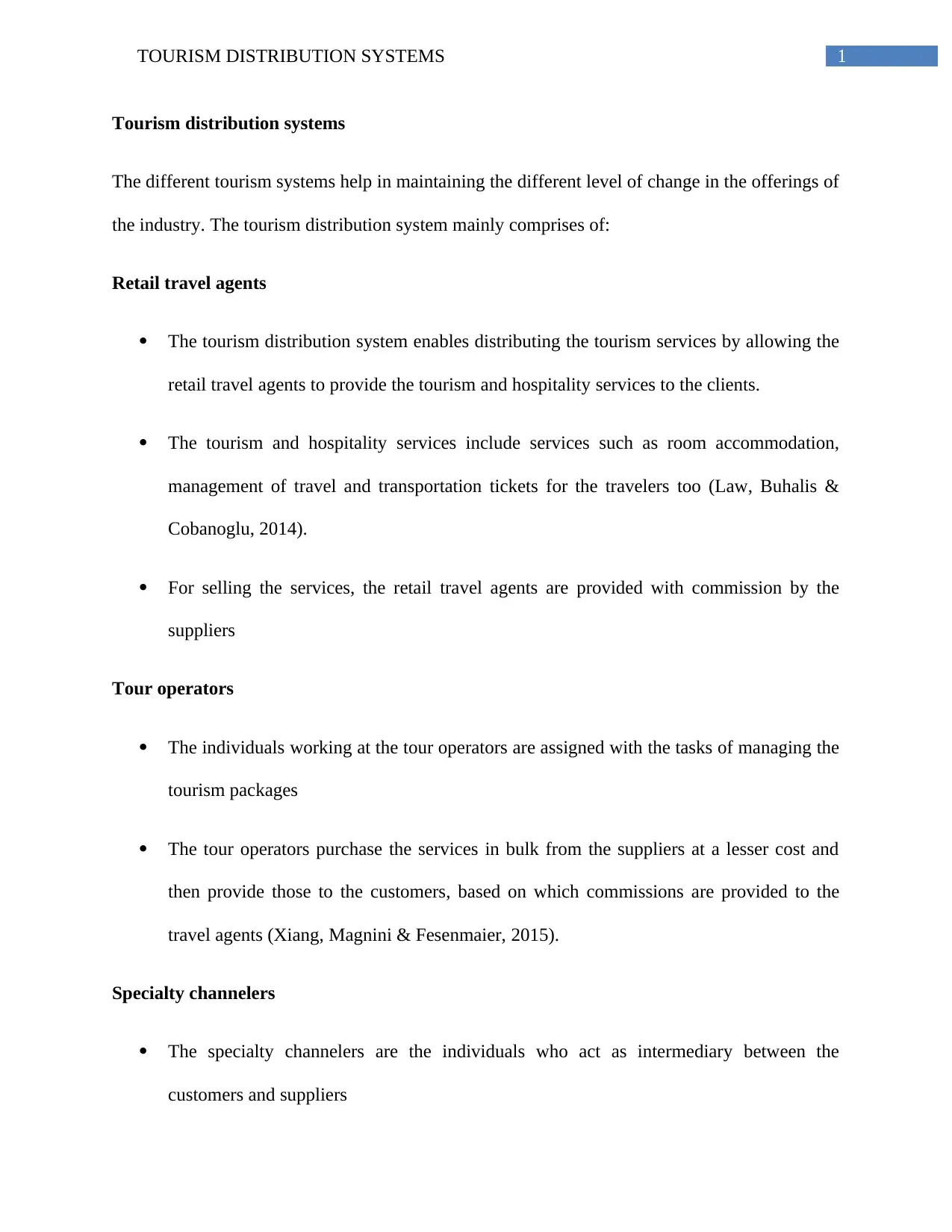
1TOURISM DISTRIBUTION SYSTEMS
Tourism distribution systems
The different tourism systems help in maintaining the different level of change in the offerings of
the industry. The tourism distribution system mainly comprises of:
Retail travel agents
The tourism distribution system enables distributing the tourism services by allowing the
retail travel agents to provide the tourism and hospitality services to the clients.
The tourism and hospitality services include services such as room accommodation,
management of travel and transportation tickets for the travelers too (Law, Buhalis &
Cobanoglu, 2014).
For selling the services, the retail travel agents are provided with commission by the
suppliers
Tour operators
The individuals working at the tour operators are assigned with the tasks of managing the
tourism packages
The tour operators purchase the services in bulk from the suppliers at a lesser cost and
then provide those to the customers, based on which commissions are provided to the
travel agents (Xiang, Magnini & Fesenmaier, 2015).
Specialty channelers
The specialty channelers are the individuals who act as intermediary between the
customers and suppliers
Tourism distribution systems
The different tourism systems help in maintaining the different level of change in the offerings of
the industry. The tourism distribution system mainly comprises of:
Retail travel agents
The tourism distribution system enables distributing the tourism services by allowing the
retail travel agents to provide the tourism and hospitality services to the clients.
The tourism and hospitality services include services such as room accommodation,
management of travel and transportation tickets for the travelers too (Law, Buhalis &
Cobanoglu, 2014).
For selling the services, the retail travel agents are provided with commission by the
suppliers
Tour operators
The individuals working at the tour operators are assigned with the tasks of managing the
tourism packages
The tour operators purchase the services in bulk from the suppliers at a lesser cost and
then provide those to the customers, based on which commissions are provided to the
travel agents (Xiang, Magnini & Fesenmaier, 2015).
Specialty channelers
The specialty channelers are the individuals who act as intermediary between the
customers and suppliers
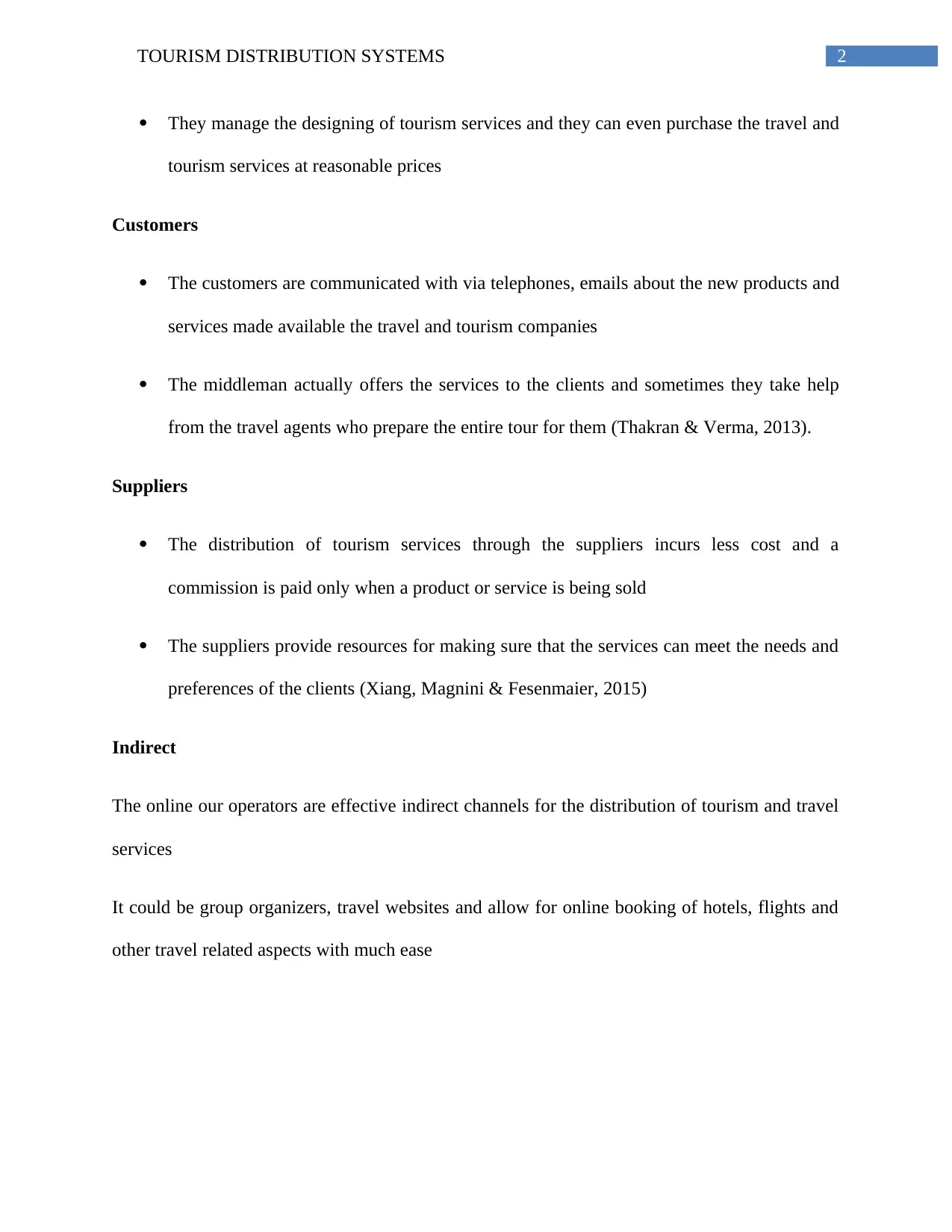
2TOURISM DISTRIBUTION SYSTEMS
They manage the designing of tourism services and they can even purchase the travel and
tourism services at reasonable prices
Customers
The customers are communicated with via telephones, emails about the new products and
services made available the travel and tourism companies
The middleman actually offers the services to the clients and sometimes they take help
from the travel agents who prepare the entire tour for them (Thakran & Verma, 2013).
Suppliers
The distribution of tourism services through the suppliers incurs less cost and a
commission is paid only when a product or service is being sold
The suppliers provide resources for making sure that the services can meet the needs and
preferences of the clients (Xiang, Magnini & Fesenmaier, 2015)
Indirect
The online our operators are effective indirect channels for the distribution of tourism and travel
services
It could be group organizers, travel websites and allow for online booking of hotels, flights and
other travel related aspects with much ease
They manage the designing of tourism services and they can even purchase the travel and
tourism services at reasonable prices
Customers
The customers are communicated with via telephones, emails about the new products and
services made available the travel and tourism companies
The middleman actually offers the services to the clients and sometimes they take help
from the travel agents who prepare the entire tour for them (Thakran & Verma, 2013).
Suppliers
The distribution of tourism services through the suppliers incurs less cost and a
commission is paid only when a product or service is being sold
The suppliers provide resources for making sure that the services can meet the needs and
preferences of the clients (Xiang, Magnini & Fesenmaier, 2015)
Indirect
The online our operators are effective indirect channels for the distribution of tourism and travel
services
It could be group organizers, travel websites and allow for online booking of hotels, flights and
other travel related aspects with much ease
⊘ This is a preview!⊘
Do you want full access?
Subscribe today to unlock all pages.

Trusted by 1+ million students worldwide
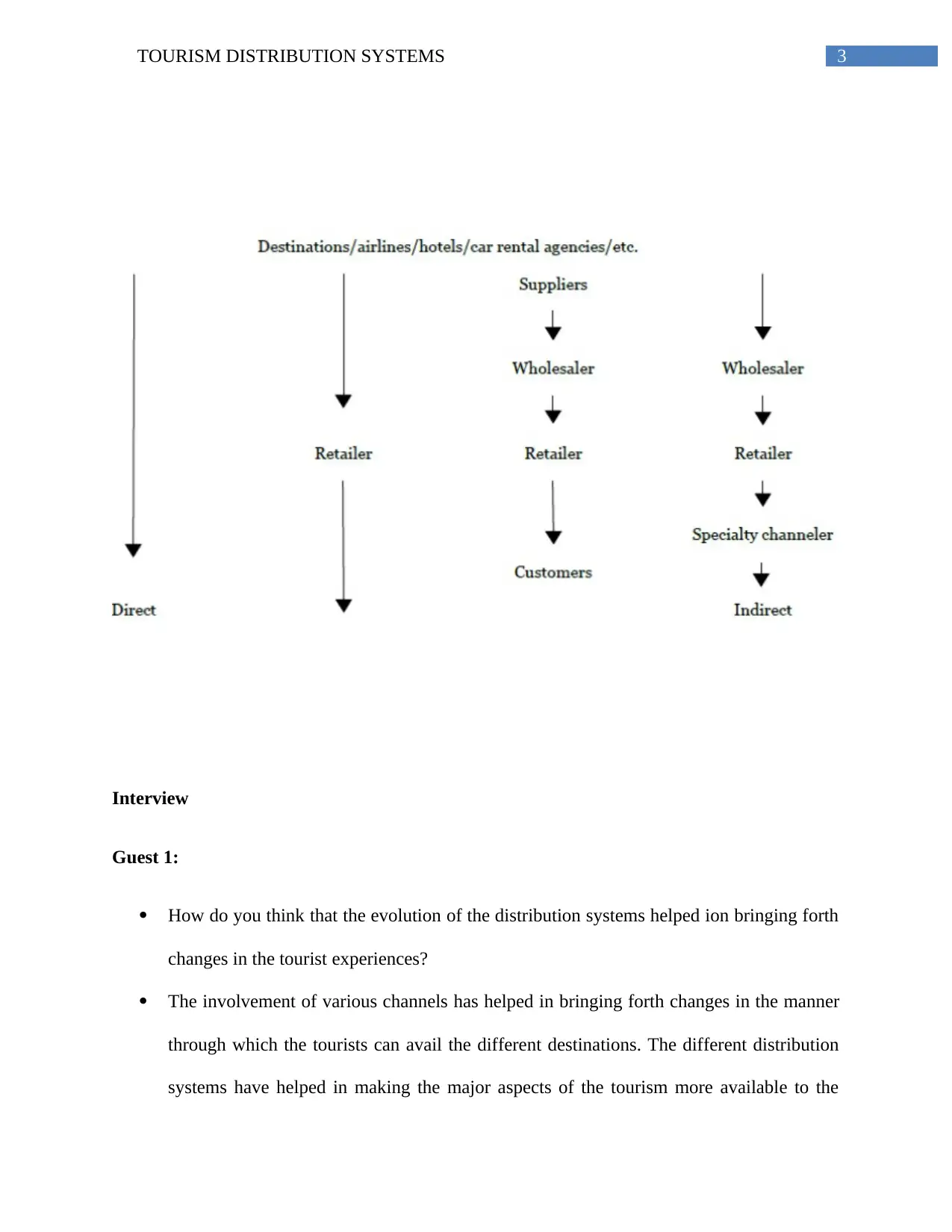
3TOURISM DISTRIBUTION SYSTEMS
Interview
Guest 1:
How do you think that the evolution of the distribution systems helped ion bringing forth
changes in the tourist experiences?
The involvement of various channels has helped in bringing forth changes in the manner
through which the tourists can avail the different destinations. The different distribution
systems have helped in making the major aspects of the tourism more available to the
Interview
Guest 1:
How do you think that the evolution of the distribution systems helped ion bringing forth
changes in the tourist experiences?
The involvement of various channels has helped in bringing forth changes in the manner
through which the tourists can avail the different destinations. The different distribution
systems have helped in making the major aspects of the tourism more available to the
Paraphrase This Document
Need a fresh take? Get an instant paraphrase of this document with our AI Paraphraser
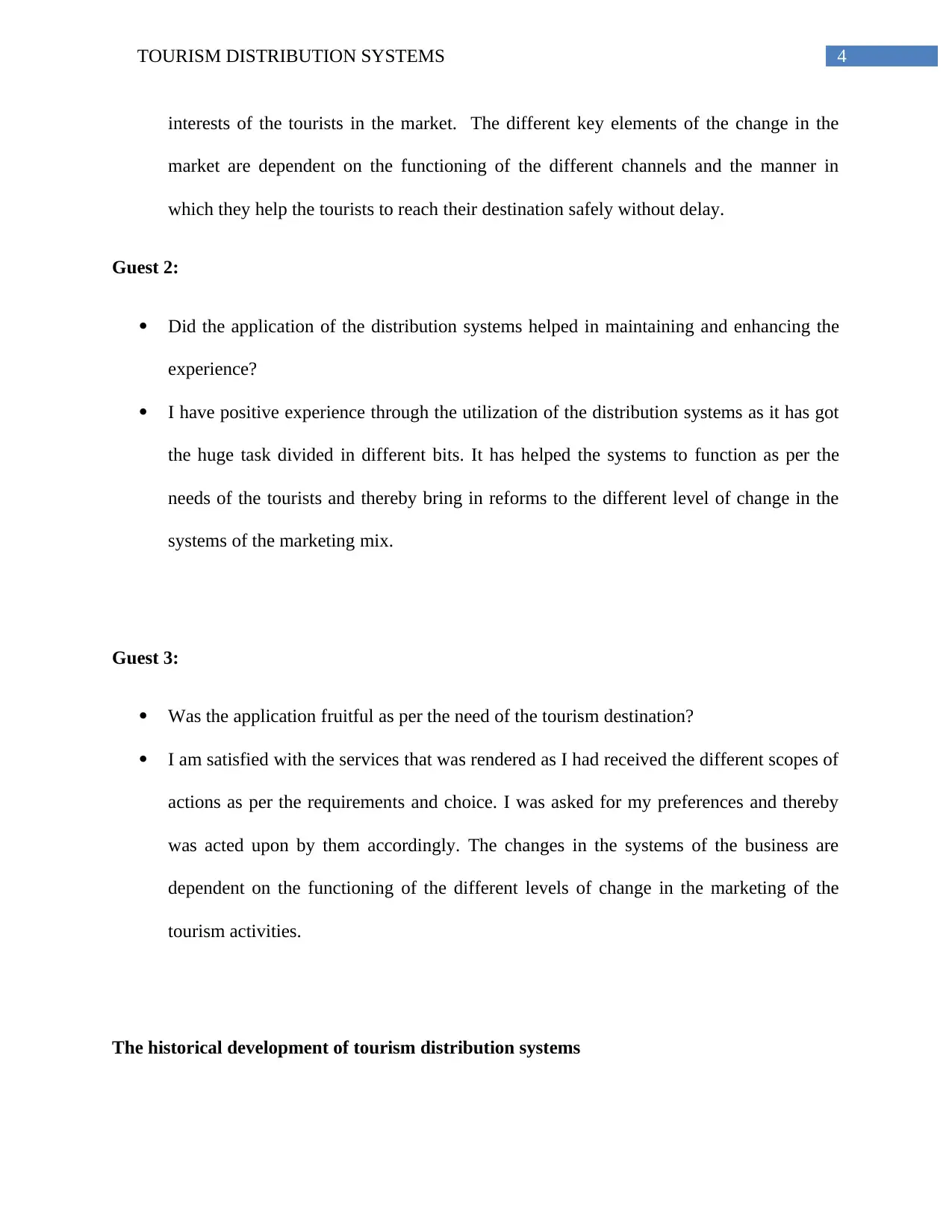
4TOURISM DISTRIBUTION SYSTEMS
interests of the tourists in the market. The different key elements of the change in the
market are dependent on the functioning of the different channels and the manner in
which they help the tourists to reach their destination safely without delay.
Guest 2:
Did the application of the distribution systems helped in maintaining and enhancing the
experience?
I have positive experience through the utilization of the distribution systems as it has got
the huge task divided in different bits. It has helped the systems to function as per the
needs of the tourists and thereby bring in reforms to the different level of change in the
systems of the marketing mix.
Guest 3:
Was the application fruitful as per the need of the tourism destination?
I am satisfied with the services that was rendered as I had received the different scopes of
actions as per the requirements and choice. I was asked for my preferences and thereby
was acted upon by them accordingly. The changes in the systems of the business are
dependent on the functioning of the different levels of change in the marketing of the
tourism activities.
The historical development of tourism distribution systems
interests of the tourists in the market. The different key elements of the change in the
market are dependent on the functioning of the different channels and the manner in
which they help the tourists to reach their destination safely without delay.
Guest 2:
Did the application of the distribution systems helped in maintaining and enhancing the
experience?
I have positive experience through the utilization of the distribution systems as it has got
the huge task divided in different bits. It has helped the systems to function as per the
needs of the tourists and thereby bring in reforms to the different level of change in the
systems of the marketing mix.
Guest 3:
Was the application fruitful as per the need of the tourism destination?
I am satisfied with the services that was rendered as I had received the different scopes of
actions as per the requirements and choice. I was asked for my preferences and thereby
was acted upon by them accordingly. The changes in the systems of the business are
dependent on the functioning of the different levels of change in the marketing of the
tourism activities.
The historical development of tourism distribution systems
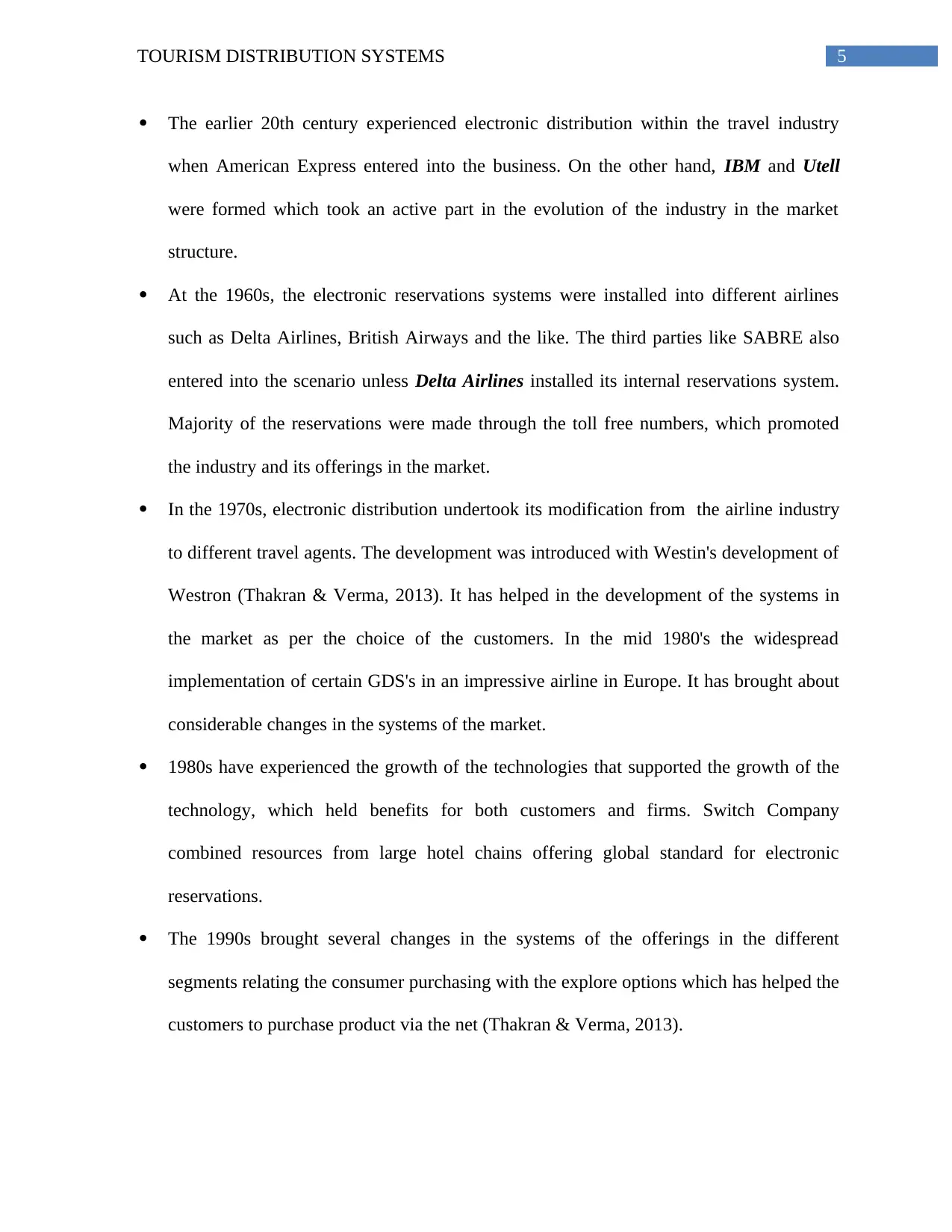
5TOURISM DISTRIBUTION SYSTEMS
The earlier 20th century experienced electronic distribution within the travel industry
when American Express entered into the business. On the other hand, IBM and Utell
were formed which took an active part in the evolution of the industry in the market
structure.
At the 1960s, the electronic reservations systems were installed into different airlines
such as Delta Airlines, British Airways and the like. The third parties like SABRE also
entered into the scenario unless Delta Airlines installed its internal reservations system.
Majority of the reservations were made through the toll free numbers, which promoted
the industry and its offerings in the market.
In the 1970s, electronic distribution undertook its modification from the airline industry
to different travel agents. The development was introduced with Westin's development of
Westron (Thakran & Verma, 2013). It has helped in the development of the systems in
the market as per the choice of the customers. In the mid 1980's the widespread
implementation of certain GDS's in an impressive airline in Europe. It has brought about
considerable changes in the systems of the market.
1980s have experienced the growth of the technologies that supported the growth of the
technology, which held benefits for both customers and firms. Switch Company
combined resources from large hotel chains offering global standard for electronic
reservations.
The 1990s brought several changes in the systems of the offerings in the different
segments relating the consumer purchasing with the explore options which has helped the
customers to purchase product via the net (Thakran & Verma, 2013).
The earlier 20th century experienced electronic distribution within the travel industry
when American Express entered into the business. On the other hand, IBM and Utell
were formed which took an active part in the evolution of the industry in the market
structure.
At the 1960s, the electronic reservations systems were installed into different airlines
such as Delta Airlines, British Airways and the like. The third parties like SABRE also
entered into the scenario unless Delta Airlines installed its internal reservations system.
Majority of the reservations were made through the toll free numbers, which promoted
the industry and its offerings in the market.
In the 1970s, electronic distribution undertook its modification from the airline industry
to different travel agents. The development was introduced with Westin's development of
Westron (Thakran & Verma, 2013). It has helped in the development of the systems in
the market as per the choice of the customers. In the mid 1980's the widespread
implementation of certain GDS's in an impressive airline in Europe. It has brought about
considerable changes in the systems of the market.
1980s have experienced the growth of the technologies that supported the growth of the
technology, which held benefits for both customers and firms. Switch Company
combined resources from large hotel chains offering global standard for electronic
reservations.
The 1990s brought several changes in the systems of the offerings in the different
segments relating the consumer purchasing with the explore options which has helped the
customers to purchase product via the net (Thakran & Verma, 2013).
⊘ This is a preview!⊘
Do you want full access?
Subscribe today to unlock all pages.

Trusted by 1+ million students worldwide
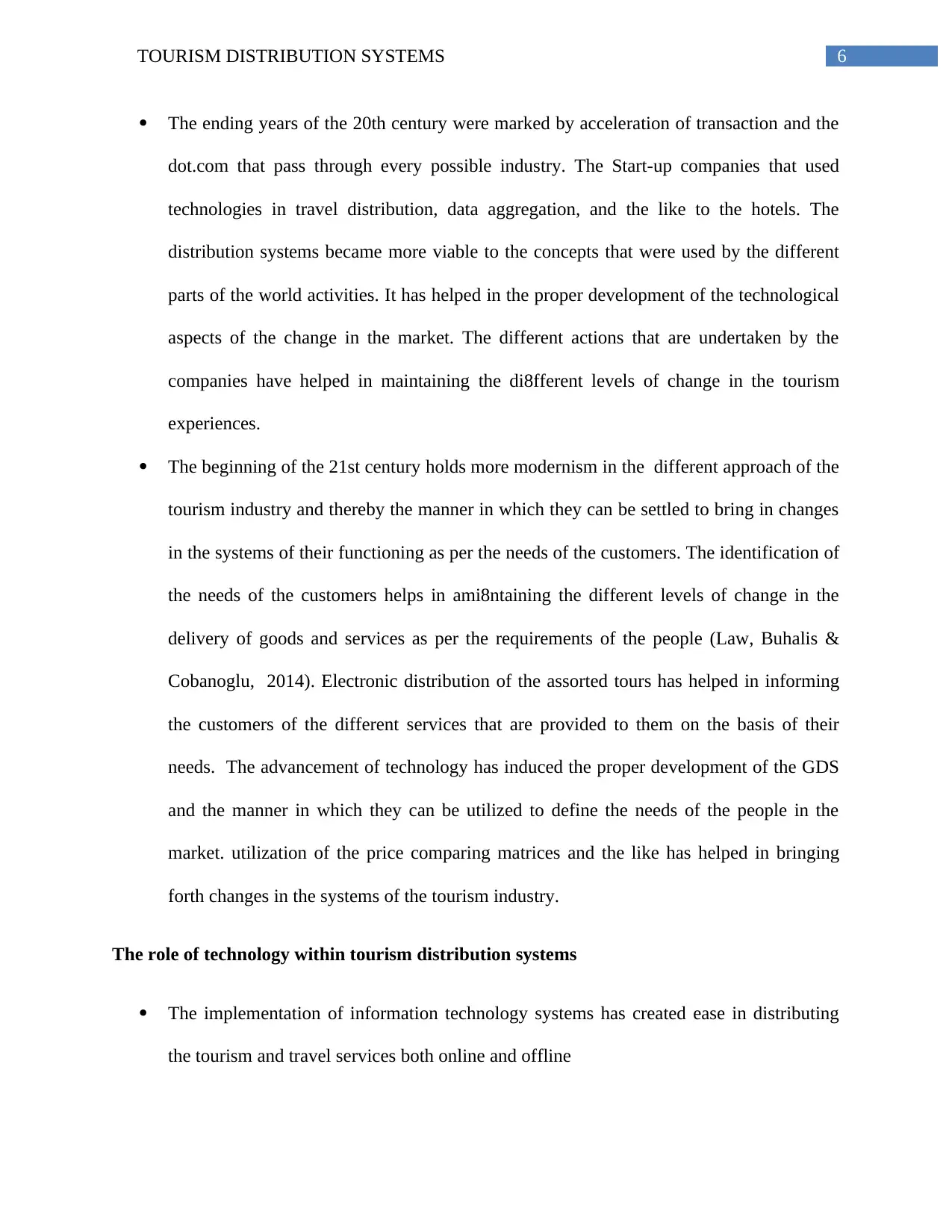
6TOURISM DISTRIBUTION SYSTEMS
The ending years of the 20th century were marked by acceleration of transaction and the
dot.com that pass through every possible industry. The Start-up companies that used
technologies in travel distribution, data aggregation, and the like to the hotels. The
distribution systems became more viable to the concepts that were used by the different
parts of the world activities. It has helped in the proper development of the technological
aspects of the change in the market. The different actions that are undertaken by the
companies have helped in maintaining the di8fferent levels of change in the tourism
experiences.
The beginning of the 21st century holds more modernism in the different approach of the
tourism industry and thereby the manner in which they can be settled to bring in changes
in the systems of their functioning as per the needs of the customers. The identification of
the needs of the customers helps in ami8ntaining the different levels of change in the
delivery of goods and services as per the requirements of the people (Law, Buhalis &
Cobanoglu, 2014). Electronic distribution of the assorted tours has helped in informing
the customers of the different services that are provided to them on the basis of their
needs. The advancement of technology has induced the proper development of the GDS
and the manner in which they can be utilized to define the needs of the people in the
market. utilization of the price comparing matrices and the like has helped in bringing
forth changes in the systems of the tourism industry.
The role of technology within tourism distribution systems
The implementation of information technology systems has created ease in distributing
the tourism and travel services both online and offline
The ending years of the 20th century were marked by acceleration of transaction and the
dot.com that pass through every possible industry. The Start-up companies that used
technologies in travel distribution, data aggregation, and the like to the hotels. The
distribution systems became more viable to the concepts that were used by the different
parts of the world activities. It has helped in the proper development of the technological
aspects of the change in the market. The different actions that are undertaken by the
companies have helped in maintaining the di8fferent levels of change in the tourism
experiences.
The beginning of the 21st century holds more modernism in the different approach of the
tourism industry and thereby the manner in which they can be settled to bring in changes
in the systems of their functioning as per the needs of the customers. The identification of
the needs of the customers helps in ami8ntaining the different levels of change in the
delivery of goods and services as per the requirements of the people (Law, Buhalis &
Cobanoglu, 2014). Electronic distribution of the assorted tours has helped in informing
the customers of the different services that are provided to them on the basis of their
needs. The advancement of technology has induced the proper development of the GDS
and the manner in which they can be utilized to define the needs of the people in the
market. utilization of the price comparing matrices and the like has helped in bringing
forth changes in the systems of the tourism industry.
The role of technology within tourism distribution systems
The implementation of information technology systems has created ease in distributing
the tourism and travel services both online and offline
Paraphrase This Document
Need a fresh take? Get an instant paraphrase of this document with our AI Paraphraser

7TOURISM DISTRIBUTION SYSTEMS
It has created convenience for the customers to book the tickets, hotel rooms and even
make proper arrangements of travel and tourism activities electronically (Law, Buhalis &
Cobanoglu, 2014)
The technological advancements can increase the usage of internet and allow the tourists
to gain access to the travel information about the travel destinations, lodging and dining
options along with making reservations of hotel rooms and flight tickets for the particular
destination (Thakran & Verma, 2013)
The management of websites, blogs, online advertising, online ordering and information
repositories along with the involvement of social media can improve brand awareness
and influence the customers to make arrangements and avail the services of the tourism
company
The computerized systems and internet usage can allow for better communication
between branches and locations, which results in streamlining the reservations and
company policies (Xiang, Magnini & Fesenmaier, 2015).
Making it easy for the customers to access information could also improve the guests’
experiences and they can use mobile communication to know about the offers, deals and
advertisements promoted within the travel and tourism sector
‘Future’ explanatory tourism distribution system’
The advancements in technology has helped the industry to bring in various subtle
changes in the systems and the performance of the organizations which functioned as per
It has created convenience for the customers to book the tickets, hotel rooms and even
make proper arrangements of travel and tourism activities electronically (Law, Buhalis &
Cobanoglu, 2014)
The technological advancements can increase the usage of internet and allow the tourists
to gain access to the travel information about the travel destinations, lodging and dining
options along with making reservations of hotel rooms and flight tickets for the particular
destination (Thakran & Verma, 2013)
The management of websites, blogs, online advertising, online ordering and information
repositories along with the involvement of social media can improve brand awareness
and influence the customers to make arrangements and avail the services of the tourism
company
The computerized systems and internet usage can allow for better communication
between branches and locations, which results in streamlining the reservations and
company policies (Xiang, Magnini & Fesenmaier, 2015).
Making it easy for the customers to access information could also improve the guests’
experiences and they can use mobile communication to know about the offers, deals and
advertisements promoted within the travel and tourism sector
‘Future’ explanatory tourism distribution system’
The advancements in technology has helped the industry to bring in various subtle
changes in the systems and the performance of the organizations which functioned as per
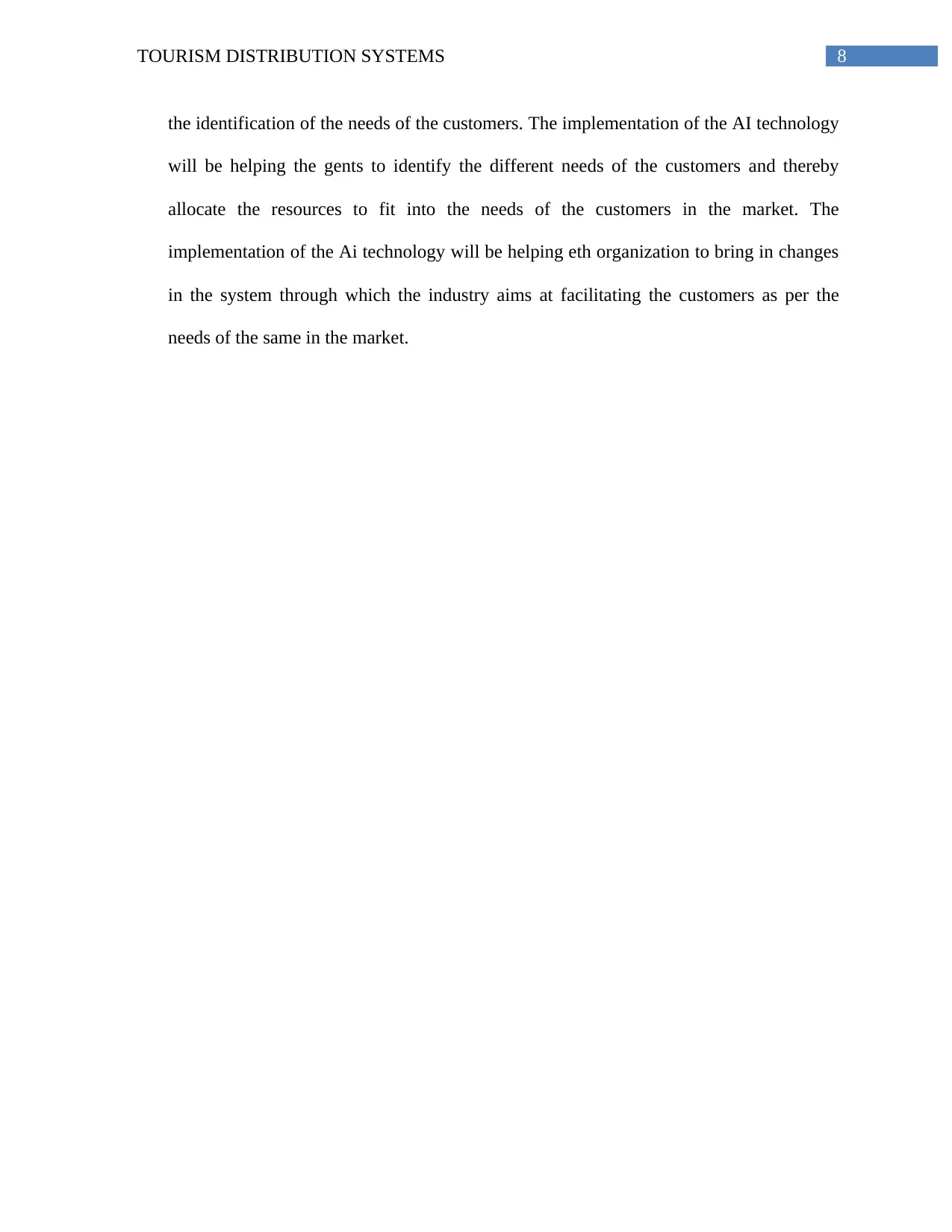
8TOURISM DISTRIBUTION SYSTEMS
the identification of the needs of the customers. The implementation of the AI technology
will be helping the gents to identify the different needs of the customers and thereby
allocate the resources to fit into the needs of the customers in the market. The
implementation of the Ai technology will be helping eth organization to bring in changes
in the system through which the industry aims at facilitating the customers as per the
needs of the same in the market.
the identification of the needs of the customers. The implementation of the AI technology
will be helping the gents to identify the different needs of the customers and thereby
allocate the resources to fit into the needs of the customers in the market. The
implementation of the Ai technology will be helping eth organization to bring in changes
in the system through which the industry aims at facilitating the customers as per the
needs of the same in the market.
⊘ This is a preview!⊘
Do you want full access?
Subscribe today to unlock all pages.

Trusted by 1+ million students worldwide
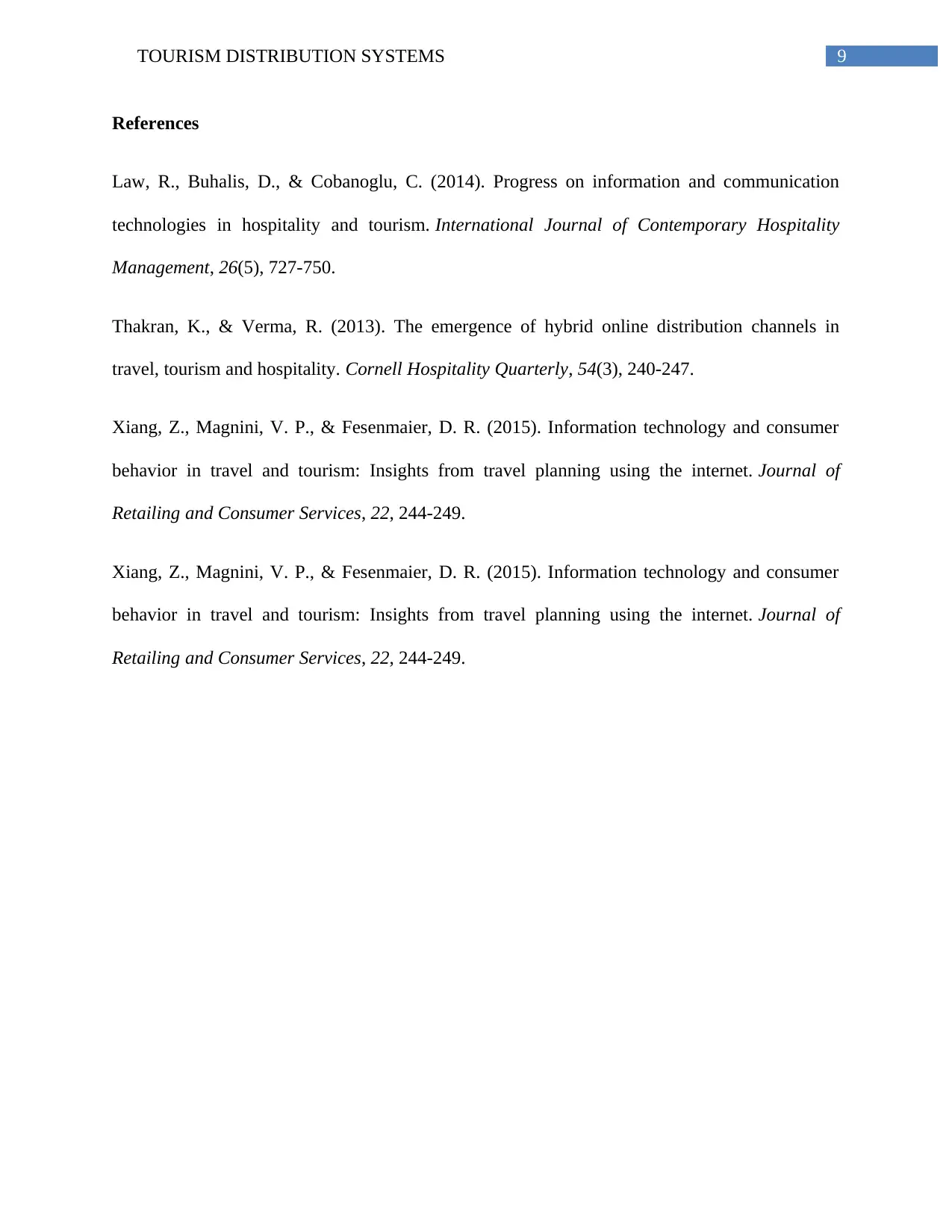
9TOURISM DISTRIBUTION SYSTEMS
References
Law, R., Buhalis, D., & Cobanoglu, C. (2014). Progress on information and communication
technologies in hospitality and tourism. International Journal of Contemporary Hospitality
Management, 26(5), 727-750.
Thakran, K., & Verma, R. (2013). The emergence of hybrid online distribution channels in
travel, tourism and hospitality. Cornell Hospitality Quarterly, 54(3), 240-247.
Xiang, Z., Magnini, V. P., & Fesenmaier, D. R. (2015). Information technology and consumer
behavior in travel and tourism: Insights from travel planning using the internet. Journal of
Retailing and Consumer Services, 22, 244-249.
Xiang, Z., Magnini, V. P., & Fesenmaier, D. R. (2015). Information technology and consumer
behavior in travel and tourism: Insights from travel planning using the internet. Journal of
Retailing and Consumer Services, 22, 244-249.
References
Law, R., Buhalis, D., & Cobanoglu, C. (2014). Progress on information and communication
technologies in hospitality and tourism. International Journal of Contemporary Hospitality
Management, 26(5), 727-750.
Thakran, K., & Verma, R. (2013). The emergence of hybrid online distribution channels in
travel, tourism and hospitality. Cornell Hospitality Quarterly, 54(3), 240-247.
Xiang, Z., Magnini, V. P., & Fesenmaier, D. R. (2015). Information technology and consumer
behavior in travel and tourism: Insights from travel planning using the internet. Journal of
Retailing and Consumer Services, 22, 244-249.
Xiang, Z., Magnini, V. P., & Fesenmaier, D. R. (2015). Information technology and consumer
behavior in travel and tourism: Insights from travel planning using the internet. Journal of
Retailing and Consumer Services, 22, 244-249.
1 out of 10
Related Documents
Your All-in-One AI-Powered Toolkit for Academic Success.
+13062052269
info@desklib.com
Available 24*7 on WhatsApp / Email
![[object Object]](/_next/static/media/star-bottom.7253800d.svg)
Unlock your academic potential
Copyright © 2020–2025 A2Z Services. All Rights Reserved. Developed and managed by ZUCOL.





